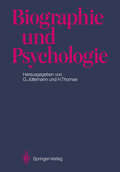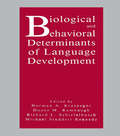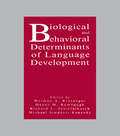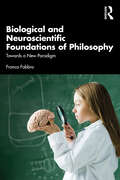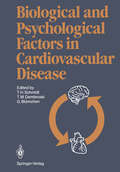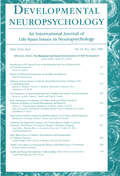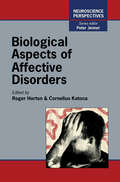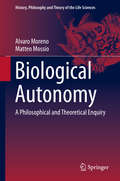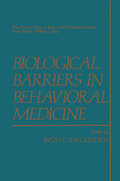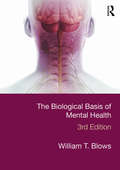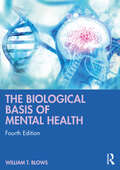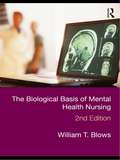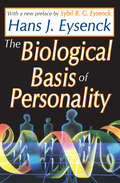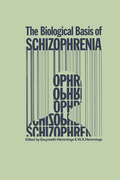- Table View
- List View
Biographieorientierte Aktivierung mit SimA-P: Selbständig im Alter
by Wolf-D. Oswald Andreas AckermannWenn alte Menschen über ihre Erinnerungen sprechen, kann das dem Verlust von Identität und Selbstwissen entgegenwirken. Der praxiserprobte Leitfaden zur biographieorientierten Aktivierung stellt neben einem kurzen allgemeinen Teil insgesamt 28 Therapieeinheiten vor. Ablaufpläne und Arbeitsmaterialien für die Gruppenarbeit erleichtern die Umsetzung. Die mitgelieferte CD-ROM enthält Kopiervorlagen. Der Band richtet sich an alle Personen, die beruflich oder ehrenamtlich im Bereich der Alltagshilfe tätig sind.
Biographies and Careers throughout Academic Life (The Changing Academy – The Changing Academic Profession in International Comparative Perspective #16)
by Jesús F. Galaz-Fontes Akira Arimoto Ulrich Teichler John BrennanThe book draws on the 2007 Changing Academic Profession international survey in order to document the personal characteristics, career trajectories, sense of identity/commitment and job satisfaction of academics in 14 countries with different levels of economic and social development and different higher education systems. With nearly 26,000 academics surveyed in 19 countries (of which 14 are reporting their results in this volume), the empirical basis of the book is the most up-to-date and far-reaching in the area.With major changes taking place both in the local and global contexts of higher education and in the working conditions within individual universities, as exemplified by increasing managerialism and performance-based funding, it is important to consider the impact of these changes on the profiles and working lives of the academic profession across different countries. But it is also important to look at the ways in which the faculty’s changing profile impacts on the organisation and management of universities and on the delivery of their central functions.Although not always obvious in the short-term, academic work and its conditions attract, incorporate and promote different types of individuals who, in turn, exert considerable influence on the nature of academic work, higher education institutions and, potentially, society. As faculty members are central to the teaching, research and service enterprise activities of higher education, it is important to understand their personal characteristics, career trajectories, sense of identity and commitment, and job satisfaction. These are central for understanding the academic profession in general and, in particular, the factors affecting their involvement and productivity in the work of their institutions. These are a complex result of a mixture of contextual factors (e.g. the status and regulatory framework of the higher education system, the features and atmosphere of the particular institution) and personal factors (e.g. gender, educational attainment, family background, attitudes to work and broader social values).This book examines the different situations facing the academic profession in individual countries and provides comparative studies of country differences.
Biological and Behavioral Determinants of Language Development
by Norman A. Krasnegor Duane M. Rumbaugh Richard L. Schiefelbusch Michael Studdert-KennedyThis book presents a current, interdisciplinary perspective on language requisites from both a biological/comparative perspective and from a developmental/learning perspective. Perspectives regarding language and language acquisition are advanced by scientists of various backgrounds -- speech, hearing, developmental psychology, comparative psychology, and language intervention. This unique volume searches for a rational interface between findings and perspectives generated by language studies with humans and with chimpanzees. Intended to render a reconsideration as to the essence of language and the requisites to its acquisition, it also provides readers with perspectives defined by various revisionists who hold that language might be other than the consequence of a mutation unique to humans and might, fundamentally, not be limited to speech.
Biological and Behavioral Determinants of Language Development
by Norman A. Krasnegor Duane M. Rumbaugh Richard L. Schiefelbusch Michael Studdert-KennedyThis book presents a current, interdisciplinary perspective on language requisites from both a biological/comparative perspective and from a developmental/learning perspective. Perspectives regarding language and language acquisition are advanced by scientists of various backgrounds -- speech, hearing, developmental psychology, comparative psychology, and language intervention. This unique volume searches for a rational interface between findings and perspectives generated by language studies with humans and with chimpanzees. Intended to render a reconsideration as to the essence of language and the requisites to its acquisition, it also provides readers with perspectives defined by various revisionists who hold that language might be other than the consequence of a mutation unique to humans and might, fundamentally, not be limited to speech.
Biological and Behavioral Determinants of Language Development
by Norman A. Krasnegor Duane M. Rumbaugh Richard L. Schiefelbusch Michael Studdert-Kennedy Esther ThelenThis book presents a current, interdisciplinary perspective on language requisites from both a biological/comparative perspective and from a developmental/learning perspective. Perspectives regarding language and language acquisition are advanced by scientists of various backgrounds -- speech, hearing, developmental psychology, comparative psychology, and language intervention. This unique volume searches for a rational interface between findings and perspectives generated by language studies with humans and with chimpanzees. Intended to render a reconsideration as to the essence of language and the requisites to its acquisition, it also provides readers with perspectives defined by various revisionists who hold that language might be other than the consequence of a mutation unique to humans and might, fundamentally, not be limited to speech.
Biological and Behavioral Determinants of Language Development
by Norman A. Krasnegor Richard L. Schiefelbusch Michael Studdert-Kennedy Duane M. RumbaughThis book presents a current, interdisciplinary perspective on language requisites from both a biological/comparative perspective and from a developmental/learning perspective. Perspectives regarding language and language acquisition are advanced by scientists of various backgrounds -- speech, hearing, developmental psychology, comparative psychology, and language intervention. This unique volume searches for a rational interface between findings and perspectives generated by language studies with humans and with chimpanzees. Intended to render a reconsideration as to the essence of language and the requisites to its acquisition, it also provides readers with perspectives defined by various revisionists who hold that language might be other than the consequence of a mutation unique to humans and might, fundamentally, not be limited to speech.
Biological and Neuroscientific Foundations of Philosophy: Towards a New Paradigm
by Franco FabbroBiological and Neuroscientific Foundations of Philosophy is an authoritative text addressing both academicians and students, and it proposes an integrated and holistic view of scientific study and presents a new paradigm by which to study philosophy. It highlights, in a systematic and sufficiently simple manner, the fundamental role of neuroscience, neuropsychology and biology within philosophical reflection. Written by an expert in neuroscience, the book draws together different strands of study to explore how scientific and neuropsychological discoveries are integral to the study of philosophy and our understanding of mind. It argues to move away from a philosophical paradigm that is based solely within physics and mathematics and to embrace more complex frames of data and knowledge of psychology and biology to advance the discipline. The book also reflects on the symbolic dimensions and the concept of "information" that characterize DNA (biology), and the psyche and language (cognitive and social neuroscience). It offers an ambitious thesis that ties together the philosophical foundations of science, the evolutionary history of human beings, social organization, communication and consciousness. This interdisciplinary work will be highly beneficial for researchers and postgraduate students of neuroscience, philosophy and biological sciences, as well as those interested in the intersection between philosophy and neuroscience.
Biological and Neuroscientific Foundations of Philosophy: Towards a New Paradigm
by Franco FabbroBiological and Neuroscientific Foundations of Philosophy is an authoritative text addressing both academicians and students, and it proposes an integrated and holistic view of scientific study and presents a new paradigm by which to study philosophy. It highlights, in a systematic and sufficiently simple manner, the fundamental role of neuroscience, neuropsychology and biology within philosophical reflection. Written by an expert in neuroscience, the book draws together different strands of study to explore how scientific and neuropsychological discoveries are integral to the study of philosophy and our understanding of mind. It argues to move away from a philosophical paradigm that is based solely within physics and mathematics and to embrace more complex frames of data and knowledge of psychology and biology to advance the discipline. The book also reflects on the symbolic dimensions and the concept of "information" that characterize DNA (biology), and the psyche and language (cognitive and social neuroscience). It offers an ambitious thesis that ties together the philosophical foundations of science, the evolutionary history of human beings, social organization, communication and consciousness. This interdisciplinary work will be highly beneficial for researchers and postgraduate students of neuroscience, philosophy and biological sciences, as well as those interested in the intersection between philosophy and neuroscience.
Biological and Psychological Factors in Cardiovascular Disease
by GerhardBlümchen Theodore M.Dembroski Thomas H. SchmidtAn opening address should ask the right questions, which we expect to answer during the coming years. A good opening address should formu late hypotheses for falsification during the conference or in the near fu ture. Mter Dr. Groen's excellent lecture yesterday, I feel better about my task, because I feel I am not alone in asking the ten questions in my ab stract. It is an honor for me to give this short paper largely based on my expe riences during 15 years as medical director of a rehabilitation center in Ba varia, as a teacher at two medical schools in Munich and Innsbruck, and as an old-fashioned holistic cardiologist. However, it also is a difficult task for me because the subject of this conference concerning biobehavioral factors in coronary heart disease is controversial, not only in the medical society, but in my own mind as well. When I organized one of the first conferences on stress and coronary heart disease in West Germany in 1976, followed by conferences in 1979 and 1980, the semantic problems between physicians and psychologists were very significant. However, communication has improved in this area during the last decade. The most encouraging event in this field was a sym posium in May 1984 in Rotenburg/Fulda on the topic "Return to Work af ter Bypass Surgery", organized by a cardiac surgeon, Dr. Walter.
The Biological and Social Determinants of Child Development: A Special Double Issue of developmental Neuropsychology
by Steven M. LeharThe Biological and Social Determinants of Child Development stimulates cross-disciplinary communication and research collaboration in the field of child development. While the papers in this issue seem diverse in terms of topic and discipline, there are a number of common themes: *critical period for brain development and the importance of specific environmental input during this period; *importance of early brain development and enriched environments is supported in articles describing findings from human studies; *potential for brain plasticity following specialized retraining is found in a compelling paper demonstrating different profiles of brain activation for normal readers vs. those who have dyslexia and younger children at high risk for development of reading disabilities; and *critical period, brain plasticity, and parallel changes in developing behavior and brain structure and functioning. As a number of papers in this issue describe potential interventions, one is relevant because it describes the numerous factors that make results of such studies have the potential to generalize to larger populations. Putting the described papers in a broad perspective, the last article argues that we cannot understand the health status of a society without understanding the health-determining influences across the life course.
The Biological and Social Determinants of Child Development: A Special Double Issue of developmental Neuropsychology
by Steven M. LeharThe Biological and Social Determinants of Child Development stimulates cross-disciplinary communication and research collaboration in the field of child development. While the papers in this issue seem diverse in terms of topic and discipline, there are a number of common themes: *critical period for brain development and the importance of specific environmental input during this period; *importance of early brain development and enriched environments is supported in articles describing findings from human studies; *potential for brain plasticity following specialized retraining is found in a compelling paper demonstrating different profiles of brain activation for normal readers vs. those who have dyslexia and younger children at high risk for development of reading disabilities; and *critical period, brain plasticity, and parallel changes in developing behavior and brain structure and functioning. As a number of papers in this issue describe potential interventions, one is relevant because it describes the numerous factors that make results of such studies have the potential to generalize to larger populations. Putting the described papers in a broad perspective, the last article argues that we cannot understand the health status of a society without understanding the health-determining influences across the life course.
Biological Aspects of Affective Disorders (ISSN)
by Cornelius KatonaBiological research in the affective disorders has been an international growth industry for several years. Biological Aspects of Affective Disorders is a comprehensive introduction to the biochemical, pharmacological, and genetic aspects constituting the abnormalities that may underline the diseases of depression and mania, together with the current understanding of the clinical features and management of affected patients.It will be of great value especially to young researchers from all disciplines contributing to this area and to trainee psychiatrists.
Biological Autonomy: A Philosophical and Theoretical Enquiry (History, Philosophy and Theory of the Life Sciences #12)
by Alvaro Moreno Matteo MossioSince Darwin, Biology has been framed on the idea of evolution by natural selection, which has profoundly influenced the scientific and philosophical comprehension of biological phenomena and of our place in Nature. This book argues that contemporary biology should progress towards and revolve around an even more fundamental idea, that of autonomy. Biological autonomy describes living organisms as organised systems, which are able to self-produce and self-maintain as integrated entities, to establish their own goals and norms, and to promote the conditions of their existence through their interactions with the environment.Topics covered in this book include organisation and biological emergence, organisms, agency, levels of autonomy, cognition, and a look at the historical dimension of autonomy. The current development of scientific investigations on autonomous organisation calls for a theoretical and philosophical analysis. This can contribute to the elaboration of an original understanding of life - including human life - on Earth, opening new perspectives and enabling fecund interactions with other existing theories and approaches. This book takes up the challenge.
Biological Barriers in Behavioral Medicine (The Springer Series in Behavioral Psychophysiology and Medicine)
by Wolfgang Von Der LindenA "New Looking Glass" for Behavioral Medicine In 1984, John Briggs, a science writer and specialist in interdisciplinary studies teaching at the New School for Social Research, and F. David Peat, a physicist who was for many years a fellow with the National Research Council of Canada, published a book about the revolutions that were taking place in physics, mathematics, chemistry, biology, and neu rophysiology and about the scientists whose new theories were changing our understanding about the nature of the universe. The title of their book was Looking Glass Universe, after Lewis Carroll's classic story of Alice and her friends, Through the Looking Glass. Briggs and Peat's book is a well-written, challenging volume about human beings and how they think about old problems in new and sometimes startling ways. I mention Briggs and Peat's book only partially because I happen to have a personal interest in the potential applications of new ways of looking at and thinking about nature and data derived from modern physics and systems theory for health psychology and behavioral medi cine (e. g. , Schwartz, 1984). In a letter Wolfgang Linden wrote to me on January 23,1987, he shared with me (at my request) his rough thoughts about his personal goals for this book.
The Biological Basis of Mental Health
by William T. BlowsThis book explores the underlying biology associated with the pathology of mental health disorders and the related nervous system. Fully revised for this third edition, each chapter has been updated to include the latest research, ideas and concepts in each field, and includes a new chapter on sleep. Integrating up-to-date pharmacological and genetic knowledge with an understanding of environmental factors that impact on human biology, The Biological Basis of Mental Health covers topics including brain development, neural communication, neurotransmitters and receptors, hormones and behaviour, genetic disorders, pharmacology, drug abuse, anxiety, schizophrenia, depression, epilepsy, subcortical degenerative diseases of the brain, dementia, developmental disorders, and sleep. Accessible and engaging, this is an essential text for mental health students, practitioners and educators.
The Biological Basis of Mental Health
by William T. BlowsThis book explores the underlying biology associated with the pathology of mental health disorders and the related nervous system. Fully revised for this third edition, each chapter has been updated to include the latest research, ideas and concepts in each field, and includes a new chapter on sleep. Integrating up-to-date pharmacological and genetic knowledge with an understanding of environmental factors that impact on human biology, The Biological Basis of Mental Health covers topics including brain development, neural communication, neurotransmitters and receptors, hormones and behaviour, genetic disorders, pharmacology, drug abuse, anxiety, schizophrenia, depression, epilepsy, subcortical degenerative diseases of the brain, dementia, developmental disorders, and sleep. Accessible and engaging, this is an essential text for mental health students, practitioners and educators.
The Biological Basis of Mental Health
by William T. BlowsThis book explores the underlying biology and neuroscience associated with mental health and wellbeing. This fully revised fourth edition includes new chapters on behavioural science, and brain-gut and brain-gender connections, as well as expanded content on memory and genetics. Integrating up-to-date pharmacological and genetic research with an understanding of environmental factors that impact on human biology, The Biological Basis of Mental Health covers topics including brain development, neural communication, neurotransmitters and receptors, hormones and behaviour, genetic disorders, pharmacology, substance misuse, anxiety, schizophrenia, depression, epilepsy, subcortical degenerative diseases of the brain, dementia, developmental disorders and sleep. This unique textbook is an essential read for all healthcare students, practitioners and educators with an interest in mental health and neuroscience.
The Biological Basis of Mental Health
by William T. BlowsThis book explores the underlying biology and neuroscience associated with mental health and wellbeing. This fully revised fourth edition includes new chapters on behavioural science, and brain-gut and brain-gender connections, as well as expanded content on memory and genetics. Integrating up-to-date pharmacological and genetic research with an understanding of environmental factors that impact on human biology, The Biological Basis of Mental Health covers topics including brain development, neural communication, neurotransmitters and receptors, hormones and behaviour, genetic disorders, pharmacology, substance misuse, anxiety, schizophrenia, depression, epilepsy, subcortical degenerative diseases of the brain, dementia, developmental disorders and sleep. This unique textbook is an essential read for all healthcare students, practitioners and educators with an interest in mental health and neuroscience.
The Biological Basis of Mental Health Nursing (Second Edition)
by William BlowsWritten by an experienced nurse lecturer who also trained as a mental health nurse, this book explores the underlying biology associated with the pathology of mental health disorders and the related nervous system. Fully revised for this second edition, the text includes three new chapters on brain development,pharmacology and learning, behavioural and developmental disorders. Integrating up-to-date pharmacological and genetic knowledge with an understanding of environmental factors that impact on human biology, The Biological Basis of Mental Health Nursing covers topics including: the physiology of neurotransmission and receptors hormones and mental health the biology of emotions, stress, anxiety and phobic states the biology of substance abuse the pharmacology of psychoactive drugs developmental disorders brain anatomy and development the biology of behaviour genetics and mental health affective disorders: depression, mania and suicide schizophrenia autism and other syndromes the ageing brain and dementia degenerative diseases of the brain epilepsy. Accessibly laid out, with many of diagrams, tables and key points at the end of each chapter, this is an essential text for mental health nursing students, practitioners and educators.
The Biological Basis of Mental Health Nursing (Second Edition) (PDF)
by William BlowsWritten by an experienced nurse lecturer who also trained as a mental health nurse, this book explores the underlying biology associated with the pathology of mental health disorders and the related nervous system. Fully revised for this second edition, the text includes three new chapters on brain development,pharmacology and learning, behavioural and developmental disorders. Integrating up-to-date pharmacological and genetic knowledge with an understanding of environmental factors that impact on human biology, The Biological Basis of Mental Health Nursing covers topics including: the physiology of neurotransmission and receptors hormones and mental health the biology of emotions, stress, anxiety and phobic states the biology of substance abuse the pharmacology of psychoactive drugs developmental disorders brain anatomy and development the biology of behaviour genetics and mental health affective disorders: depression, mania and suicide schizophrenia autism and other syndromes the ageing brain and dementia degenerative diseases of the brain epilepsy. Accessibly laid out, with many of diagrams, tables and key points at the end of each chapter, this is an essential text for mental health nursing students, practitioners and educators.
The Biological Basis of Personality
by Hans EysenckThis classic is one of the most cited and novel approaches to psychology ever written. Hans Eysenck presents a descriptive and causal model of human personality in accord with the major concepts of experimental psychology and the physiological and neurological mechanisms that form the biological basis of behavior patterns. His proposal for an alliance between personality and physiology represented a major innovation in the field of psychology, distinguished his research from his contemporaries, and set the stage for a wealth of research to come. Before this foundational work, Eysenck had initially constructed a model of personality in such works as Dimensions of Personality and The Experimental Study of Personality, but these were primarily descriptive in nature. A second phase of research included his Dynamics of Anxiety and Hysteria and Experiments with Drugs, where he provided causal analysis by reference to concepts then current in experimental psychology. The Biological Basis of Personality represents Eysenck's third phase, when he dug deeper to find biological causes underlying the psychological concepts of emotion, excitation, and inhibition--which had formed the building blocks of his earlier efforts. In this work, the causal links he postulates between personality variables and neurological and physiological discoveries establish a realistic model that takes theory out of the field of mere speculation. As Sybil Eysenck makes clear in her new preface, this book paved the way for a "marriage" of the experimental and individual difference approach in personality psychology. As Sybil Eysenck makes clear in her new preface, this book paved the way for a "marriage" of the experimental and individual difference approach in personality psychology.
The Biological Basis of Personality
by Hans EysenckThis classic is one of the most cited and novel approaches to psychology ever written. Hans Eysenck presents a descriptive and causal model of human personality in accord with the major concepts of experimental psychology and the physiological and neurological mechanisms that form the biological basis of behavior patterns. His proposal for an alliance between personality and physiology represented a major innovation in the field of psychology, distinguished his research from his contemporaries, and set the stage for a wealth of research to come.Before this foundational work, Eysenck had initially constructed a model of personality in such works as Dimensions of Personality and The Experimental Study of Personality, but these were primarily descriptive in nature. A second phase of research included his Dynamics of Anxiety and Hysteria and Experiments with Drugs, where he provided causal analysis by reference to concepts then current in experimental psychology. The Biological Basis of Personality represents Eysenck's third phase, when he dug deeper to find biological causes underlying the psychological concepts of emotion, excitation, and inhibition--which had formed the building blocks of his earlier efforts. In this work, the causal links he postulates between personality variables and neurological and physiological discoveries establish a realistic model that takes theory out of the field of mere speculation.As Sybil Eysenck makes clear in her new preface, this book paved the way for a "marriage" of the experimental and individual difference approach in personality psychology.As Sybil Eysenck makes clear in her new preface, this book paved the way for a "marriage" of the experimental and individual difference approach in personality psychology.
The Biological Basis of Personality
by Hans EysenckThis classic is one of the most cited and novel approaches to psychology ever written. Hans Eysenck presents a descriptive and causal model of human personality in accord with the major concepts of experimental psychology and the physiological and neurological mechanisms that form the biological basis of behavior patterns. His proposal for an alliance between personality and physiology represented a major innovation in the field of psychology, distinguished his research from his contemporaries, and set the stage for a wealth of research to come.Before this foundational work, Eysenck had initially constructed a model of personality in such works as Dimensions of Personality and The Experimental Study of Personality, but these were primarily descriptive in nature. A second phase of research included his Dynamics of Anxiety and Hysteria and Experiments with Drugs, where he provided causal analysis by reference to concepts then current in experimental psychology. The Biological Basis of Personality represents Eysenck's third phase, when he dug deeper to find biological causes underlying the psychological concepts of emotion, excitation, and inhibition--which had formed the building blocks of his earlier efforts. In this work, the causal links he postulates between personality variables and neurological and physiological discoveries establish a realistic model that takes theory out of the field of mere speculation.As Sybil Eysenck makes clear in her new preface, this book paved the way for a "marriage" of the experimental and individual difference approach in personality psychology.As Sybil Eysenck makes clear in her new preface, this book paved the way for a "marriage" of the experimental and individual difference approach in personality psychology.
The Biological Basis of Schizophrenia
by Gwynneth Hemmings W. A. HemmingsFor years lip service has been paid to a belief in a biological basis for schizophrenia, but ,nevertheless psychosocial and psychodynamic "theories" of schizophrenia have been promulgated, and these have detracted from the all important biological work, Eclecticism has ruled the day and has caused considerable confusion, As a result research in schizophrenia has not progressed as fast as it should have done and treatment has been less effective than it could otherwise have been. This book is devoted to a wholly biological approach to the problem of schizophrenia, in the hope that many more workers will enter this exciting field of research. A wide variety of topics is covered, including brain structure; the genetics, pathogenesis and treatment of schizophrenia; a consideration of dietary and immunological factors and finally a chapter on alcoholism as it seems possible that the problems of schizophrenia and addiction are linked. We are grateful to all our contributors and to MTP Press for their enthusiasm for this book. Gwynneth P Hemmings William A Hemmings XI SECTION 1: Structure 1 The brain stem reticular formation K. E. WEBSTER There can be no question that the brain stem reticular lormation no longer exercises the same fascination for neurologists that it did a quarter of a century ago.
